This document provides an overview of Chapter 28 from an Art History textbook on art and Pacific cultures. It begins with learning objectives for the chapter focused on identifying visual hallmarks of Pacific art, interpreting meanings and themes, and relating art to cultural contexts. It then provides summaries of the art and cultures of major Pacific regions, including Australia, Melanesia, Micronesia, Polynesia, and specific areas like New Guinea and New Ireland/New Britain. For each region, it highlights characteristics of art forms, materials, and cultural practices, providing examples of artworks with descriptions and images.


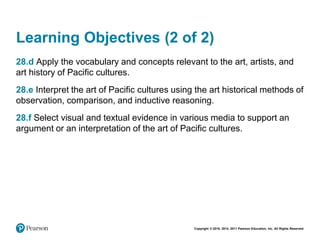
![THE BARUNGA STATEMENT
Various artists from Arnhem Land and central Australia. 1988. Ochers on composition
board with collage of printed text on paper, 48" × 47-1/4" (122 × 120 cm).
Reproduced with permission of the Northern and Central Land Councils. Reproduced
with the permission of the Northern and Central Land Councils. Gifts Collection, courtesy
of Parliament House Art Collection, Canberra ACT. [Fig. 28-01]](https://image.slidesharecdn.com/0134484592ch28-190210221732/85/0134484592-ch28-4-320.jpg)

![PACIFIC CULTURAL-GEOGRAPHIC REGIONS
The Pacific cultures are spread over four vast areas: Australia, Melanesia, Micronesia,
and Polynesia. [Map 28-01]](https://image.slidesharecdn.com/0134484592ch28-190210221732/85/0134484592-ch28-6-320.jpg)
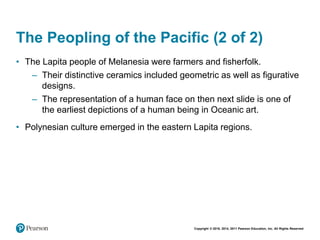
![FRAGMENTS OF A LARGE LAPITA JAR
From Venumbo Reef, Santa Cruz Island, Solomon Islands. c. 1200–1100 BCE.
Clay, height of human face motif approx. 1-1/2" (4 cm).
Courtesy of the Anthropology Photographic Archive, Department of Anthropology, The
University of Auckland. [Fig. 28-02]](https://image.slidesharecdn.com/0134484592ch28-190210221732/85/0134484592-ch28-8-320.jpg)


![Jimmy Midjaw Midjaw THREE DANCERS AND TWO MUSICIANS: CORROBOREE OF
MIMI, SPIRITS OF THE ROCKS
Minjilang (Croker Island), West Arnhem Land, Australia. Mid 20th century.
Natural pigments on eucalyptus bark, 23" × 35" (59 × 89 cm).
Musée du Quai Branly, Paris, France. (MNAO 64.9.103). Photo © RMN-Grand Palais
(musée du quai Branly)/Jean-Gilles Berizzi. [Fig. 28-03]](https://image.slidesharecdn.com/0134484592ch28-190210221732/85/0134484592-ch28-11-320.jpg)



![EXTERIOR OF KORAMBO (HAUS TAMBARAN)
Kinbangwa village, Sepik River, Papua New Guinea.
Abelam, 20th century. Mandeville Special Collections Library Geisel Library, University of
California, San Diego. Photo: Anthony Forge, 1962. [Fig. 28-04]](https://image.slidesharecdn.com/0134484592ch28-190210221732/85/0134484592-ch28-15-320.jpg)

![WOMEN WEARING NET BAGS (BILUM)
Wahgi Valley, Western Highlands Province, Papua New Guinea.
1990.
Michael O'Hanlon. [Fig. 28-05]](https://image.slidesharecdn.com/0134484592ch28-190210221732/85/0134484592-ch28-17-320.jpg)

![ASMAT ANCESTRAL SPIRIT POLES (BISJ)
Buepis village, Fajit River, West Papua Province, Indonesia. c. 1960.
Wood, paint, palm leaves, and fiber, height approx. 18' (5.48 m).
© 2016. Image copyright The Metropolitan Museum of Art/Art Resource, NY. [Fig. 28-06]](https://image.slidesharecdn.com/0134484592ch28-190210221732/85/0134484592-ch28-19-320.jpg)

![MALAGAN DISPLAY
Medina village, New Ireland, Papua New Guinea. c. 1930.
Height 6'10-5/8" (2.1 m), width 11'5-3/4" (3.5 m).
Museum für Völkerkunde, Basel, Switzerland. © Museum der Kulturen, Basel,
Switzerland. Photo: Peter Horner 1978. All rights reserved. [Fig. 28-07]](https://image.slidesharecdn.com/0134484592ch28-190210221732/85/0134484592-ch28-21-320.jpg)

![TUBUAN MASK BEING DANCED
Tolai people, Duke of York Islands, New Britain, Papua New Guinea. c. 1990.
Cloth, paint, fiber, and feathers.
Photo: Caroline Yacoe. [Fig. 28-08]](https://image.slidesharecdn.com/0134484592ch28-190210221732/85/0134484592-ch28-23-320.jpg)


![WAPEPE NAVIGATION CHART
Marshall Islands. 19th century.
Sticks, coconut fiber, and shells, 29-1/2" × 29-1/2" (75 × 75 cm).
Peabody Essex Museum, Salem. Courtesy Peabody Essex Museum. Photo: Jeffrey
Dykes. [Fig. 28-09]](https://image.slidesharecdn.com/0134484592ch28-190210221732/85/0134484592-ch28-26-320.jpg)

![THE COMPLEX OF NAN MADOL
Pohnpei, Federated States of Micronesia. c. 1200/1300–c. 1500/1600.
[Fig. Map 28-02]](https://image.slidesharecdn.com/0134484592ch28-190210221732/85/0134484592-ch28-28-320.jpg)
![ROYAL MORTUARY COMPOUND, NAN MADOL
Pohnpei, Federated States of Micronesia.
Basalt blocks, wall height up to 25' (7.62 m).
© Stephen Alvarez/ National Geographic/Getty Images. [Fig. 28-10]](https://image.slidesharecdn.com/0134484592ch28-190210221732/85/0134484592-ch28-29-320.jpg)


![Raharuhi Rukupo, master carver TE-HAU-KI-TURANGA (MAORI MEETING HOUSE)
Gisborne/Turanga, New Zealand; built and owned by the Rongowhakaata people of
Turanga. 1842–1843, restored in 1935. Wood, shell, grass, flax, and pigments.
Museum of New Zealand/Te Papa Tongarewa, Wellington. (Neg. B18358). Museum of
New Zealand Te Papa Tongarewa. [Fig. 28-11]](https://image.slidesharecdn.com/0134484592ch28-190210221732/85/0134484592-ch28-32-320.jpg)

![CARVED FIGURE FROM STOREHOUSE DOORWAY
Ngäti Päoa, Hauraki Gulf, New Zealand. 1500–1800.
Wood, height 33-7/8" (86 cm). Museum of New Zealand/Te Papa Tongarewa, Wellington.
Museum of New Zealand Te Papa Tongarewa/Michael Hall. [Fig. 28-12]](https://image.slidesharecdn.com/0134484592ch28-190210221732/85/0134484592-ch28-34-320.jpg)
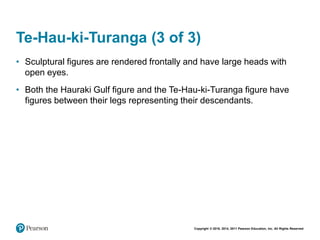
![POUPOU (PANEL)
From Te-Hau-ki-Turanga. Wood and red pigment, height 4'7" (140 cm).
Museum of New Zealand/Te Papa Tongarewa, Wellington. Museum of New Zealand Te
Papa Tongarewa. [Fig. 28-13]](https://image.slidesharecdn.com/0134484592ch28-190210221732/85/0134484592-ch28-36-320.jpg)


![TATTOOED NATIVE OF NUKAHIVA
Plate 10 in A. J. von Krusenstern's Voyage Round the World in the Years 1803, 1804,
1805, 1806, ... 1813. Richard Belgrave Hoppner (trans.). London: J. Murray.
© The British Library Board (981.i.8 frontispiece). [Fig. 28-14]](https://image.slidesharecdn.com/0134484592ch28-190210221732/85/0134484592-ch28-39-320.jpg)
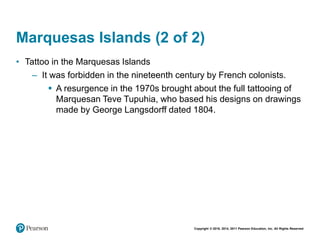
![DANCER FROM THE MARQUESAS ART AND CULTURE FESTIVAL
2013. Ua Huka, Marquesas.
Photographer Lionel Gouverneur. Photo: Lionel Gouverneur. [Fig. 28-15]](https://image.slidesharecdn.com/0134484592ch28-190210221732/85/0134484592-ch28-41-320.jpg)

![FEATHER CLOAK (KNOWN AS THE KEARNY CLOAK)
Hawaii. c. 1843.
Red, yellow, and black feathers, olona cordage, and netting, length 55-3/4" (143 cm).
Bishop Museum, Honolulu. [Fig. 28-16]](https://image.slidesharecdn.com/0134484592ch28-190210221732/85/0134484592-ch28-43-320.jpg)


![MOAI ANCESTOR FIGURES
Ahu Nau Nau, Rapa Nui (Easter Island). c. 1000?–1500 CE, restored 1978.
Volcanic stone (tufa), average height approx. 36' (11 m).
© Shin/Shutterstock. [Fig. 28-17]](https://image.slidesharecdn.com/0134484592ch28-190210221732/85/0134484592-ch28-46-320.jpg)

![TAPA (SIAPO VALA)
Samoa. 20th century. 58-5/8" × 57" (149 × 145 cm).
Auckland Museum, New Zealand. (AM 46892). Photo: Krzysztof Pfeiffer, Auckland
Museum. [Fig. 28-18]](https://image.slidesharecdn.com/0134484592ch28-190210221732/85/0134484592-ch28-48-320.jpg)


![MUSICIANS FROM PAPUA NEW GUINEA AT THE FESTIVAL OF PACIFIC ARTS
Pago Pago, American Samoa, 2008.
Photo: Caroline Yacoe. [Fig. 28-19]](https://image.slidesharecdn.com/0134484592ch28-190210221732/85/0134484592-ch28-51-320.jpg)
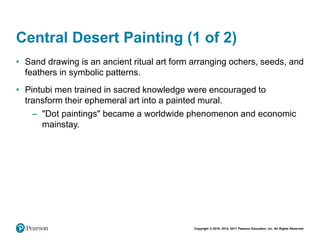

![A CLOSER LOOK: Man's Love Story by Clifford Possum Tjapaltjarri.
1978. Synthetic polymer paint on canvas. 6'11-3/4" × 8'4-1/4" (2.15 × 2.57 m).
Art Gallery of South Australia, Adelaide. Visual Arts Board of the Australia Council
Contemporary Art Purchase Grant, 1980. © Estate of the artist 2016, licensed by
Aboriginal Artists Agency Ltd. [Fig. 28-20]](https://image.slidesharecdn.com/0134484592ch28-190210221732/85/0134484592-ch28-54-320.jpg)
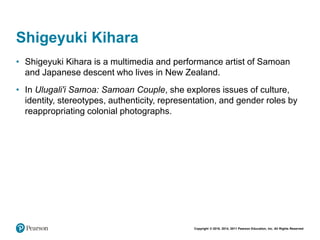
![Shigeyuki Kihara ULUGALI'I SAMOA: SAMOAN COUPLE
2004–2005. C-type photograph, edition 5, 31-1/2" × 23-3/5" (80 × 60 cm).
Metropolitan Museum of Art, New York. Gift of Shigeyuki Kihara, 2009. © 2016. Image
copyright The Metropolitan Museum of Art/Art Resource/Scala, Florence. [Fig. 28-21]](https://image.slidesharecdn.com/0134484592ch28-190210221732/85/0134484592-ch28-56-320.jpg)

